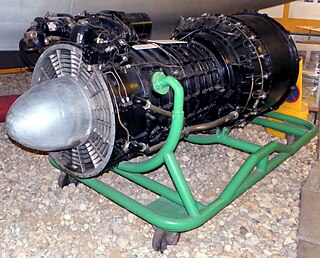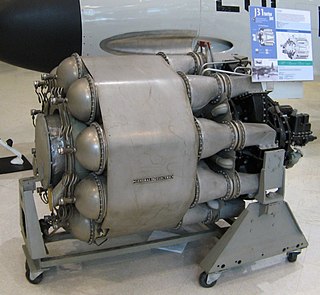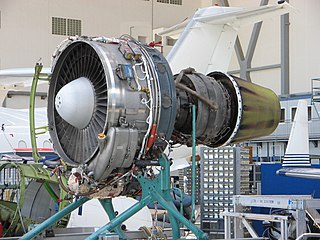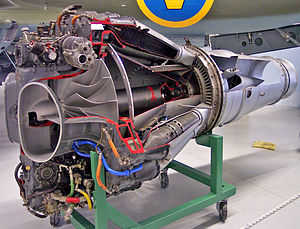
A jet engine is a type of reaction engine discharging a fast-moving jet that generates thrust by jet propulsion. While this broad definition can include rocket, water jet, and hybrid propulsion, the term jet engine typically refers to an internal combustion airbreathing jet engine such as a turbojet, turbofan, ramjet, or pulse jet. In general, jet engines are internal combustion engines.

The turbojet is an airbreathing jet engine, typically used in aircraft. It consists of a gas turbine with a propelling nozzle. The gas turbine has an air inlet which includes inlet guide vanes, a compressor, a combustion chamber, and a turbine. The compressed air from the compressor is heated by burning fuel in the combustion chamber and then allowed to expand through the turbine. The turbine exhaust is then expanded in the propelling nozzle where it is accelerated to high speed to provide thrust. Two engineers, Frank Whittle in the United Kingdom and Hans von Ohain in Germany, developed the concept independently into practical engines during the late 1930s.

The de Havilland Vampire is a British jet fighter which was developed and manufactured by the de Havilland Aircraft Company. It was the second jet fighter to be operated by the RAF, after the Gloster Meteor, and the first to be powered by a single jet engine.

The Rolls-Royce RB.41 Nene is a 1940s British centrifugal compressor turbojet engine. The Nene was a complete redesign, rather than a scaled-up Rolls-Royce Derwent with a design target of 5,000 lbf (22 kN), making it the most powerful engine of its era. It was Rolls-Royce's third jet engine to enter production, and first ran less than 6 months from the start of design. It was named after the River Nene in keeping with the company's tradition of naming its jet engines after rivers.

The General Electric/Allison J35 was the United States Air Force's first axial-flow compressor jet engine. Originally developed by General Electric in parallel with the Whittle-based centrifugal-flow J33, the J35 was a fairly simple turbojet, consisting of an eleven-stage axial-flow compressor and a single-stage turbine. With the afterburner, which most models carried, it produced a thrust of 7,400 lbf (33 kN).

The Rolls-Royce RB.37 Derwent is a 1940s British centrifugal compressor turbojet engine, the second Rolls-Royce jet engine to enter production. It was an improved version of the Rolls-Royce Welland, which itself was a renamed version of Frank Whittle's Power Jets W.2B. Rolls-Royce inherited the Derwent design from Rover when they took over their jet engine development in 1943.

The Rolls-Royce RB.23 Welland was Britain's first production jet engine. It entered production in 1943 for the Gloster Meteor. The name Welland is taken from the River Welland, in keeping with the Rolls-Royce policy of naming early jet engines after rivers based on the idea of continuous flow, air through the engine and water in a river.
This article outlines the important developments in the history of the development of the air-breathing (duct) jet engine. Although the most common type, the gas turbine powered jet engine, was certainly a 20th-century invention, many of the needed advances in theory and technology leading to this invention were made well before this time.

The Metropolitan-Vickers F.2 is an early turbojet engine and the first British design to be based on an axial-flow compressor. It was an extremely advanced design for the era, using a nine-stage axial compressor, annular combustor, and a two-stage turbine.

The de Havilland Ghost was the de Havilland Engine Company's second design of a turbojet engine to enter production and the world's first gas turbine engine to enter airline service. The Ghost powered the de Havilland Venom, de Havilland Comet and SAAB 29 Tunnan. It was a scaled-up development of the Goblin.

Major Frank Bernard Halford CBE FRAeS was an English aircraft engine designer. He is best known for the series of de Havilland Gipsy engines, widely used by light aircraft in the 1920s and 30s.

The de Havilland DH 108 "Swallow" was a British experimental aircraft designed by John Carver Meadows Frost in October 1945. The DH 108 featured a tailless, swept wing with a single vertical stabilizer, similar to the layout of the wartime German Messerschmitt Me 163 Komet. Initially designed to evaluate swept wing handling characteristics at low and high subsonic speeds for the proposed early tailless design of the Comet airliner, three examples of the DH 108 were built to Air Ministry specifications E.18/45. With the adoption of a conventional tail for the Comet, the aircraft were used instead to investigate swept wing handling up to supersonic speeds. All three prototypes were lost in fatal crashes.

The General Electric/Allison J33 is a development of the General Electric J31, enlarged to produce significantly greater thrust, starting at 4,000 lbf (18 kN) and ending at 4,600 lbf (20 kN) with an additional low-altitude boost to 5,400 lbf (24 kN) with water-alcohol injection.

The de Havilland PS.23 or PS.52 Gyron, originally the Halford H-4, was Frank Halford's last turbojet design while working for de Havilland. Intended to outpower any design then under construction, the Gyron was the most powerful engine of its era, producing 20,000 lbf (89 kN) "dry", and 27,000 lbf (120 kN) with afterburner.

The General Electric J31 was the first jet engine to be mass-produced in the United States.

The Lycoming ALF 502/LF 507 is a geared turbofan engine produced by Lycoming Engines, AlliedSignal, and then Honeywell Aerospace.

The Rolls-Royce RB.141 Medway was a large low-bypass turbofan engine designed, manufactured and tested in prototype form by Rolls-Royce in the early-1960s. The project was cancelled due to changes in market requirements that also led to the development and production of the smaller but similar Rolls-Royce Spey, and the cancellation of the Armstrong Whitworth AW.681 military transport aircraft project.

The Power Jets W.1 was a British turbojet engine designed by Frank Whittle and Power Jets. The W.1 was built under contract by British Thomson-Houston (BTH) in the early 1940s. It is notable for being the first British jet engine to fly, as the "Whittle Supercharger Type W1", powering the Gloster E.28/39 on its maiden flight at RAF Cranwell on 15 May 1941. The W.1 was superseded by the Power Jets W.2.
The General Electric I-A was the first working jet engine in the United States, manufactured by General Electric (GE) and achieving its first run on April 18, 1942.
The familiar study of jet aircraft treats jet thrust with a "black box" description which only looks at what goes into the jet engine, air and fuel, and what comes out, exhaust gas and an unbalanced force. This force, called thrust, is the sum of the momentum difference between entry and exit and any unbalanced pressure force between entry and exit, as explained in "Thrust calculation".




















